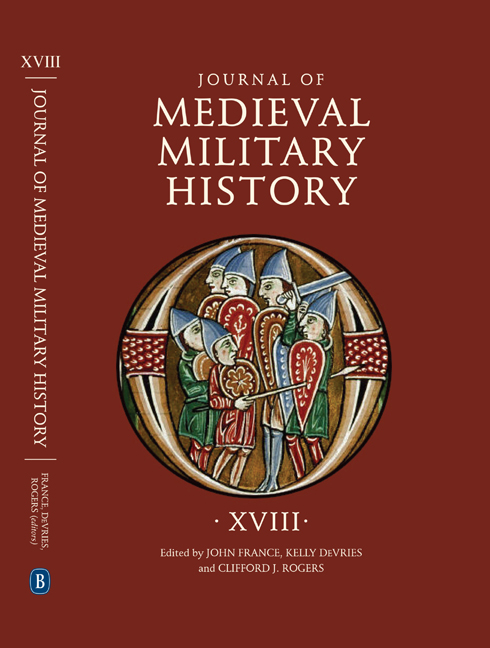Book contents
- Frontmatter
- Contents
- List of Illustrations
- 1 The Eastern Campaigns of King Henry II of Germany, 1003–17
- 2 Peace, Popular Empowerment and the First Crusade
- 3 The Transformation of Naval Warfare in Scandinavia during the Twelfth Century
- 4 Auxiliary Peoples and Military Reform on Hungary’s Western Frontier in the Thirteenth Century
- 5 What Types of Sources Did Medieval Chroniclers Use to Narrate Battles? (England and France, Twelfth to Fifteenth Centuries)
- 6 Experimental Tests of Arrows against Mail and Padding
- 7 Four Misunderstood Gunpowder Recipes of the Fourteenth Century
- 8 The Earliest Middle English Recipes for Gunpowder
- 9 Horses and Horsemen in Fifteenth-Century Siege Warfare, with Particular Reference to the Later Hundred Years War
- 10 Supplying the Army: The Siege of Pisa, 1499
- List of Contributors
- Journal of Medieval Military History 1477–545X
8 - The Earliest Middle English Recipes for Gunpowder
Published online by Cambridge University Press: 06 October 2020
- Frontmatter
- Contents
- List of Illustrations
- 1 The Eastern Campaigns of King Henry II of Germany, 1003–17
- 2 Peace, Popular Empowerment and the First Crusade
- 3 The Transformation of Naval Warfare in Scandinavia during the Twelfth Century
- 4 Auxiliary Peoples and Military Reform on Hungary’s Western Frontier in the Thirteenth Century
- 5 What Types of Sources Did Medieval Chroniclers Use to Narrate Battles? (England and France, Twelfth to Fifteenth Centuries)
- 6 Experimental Tests of Arrows against Mail and Padding
- 7 Four Misunderstood Gunpowder Recipes of the Fourteenth Century
- 8 The Earliest Middle English Recipes for Gunpowder
- 9 Horses and Horsemen in Fifteenth-Century Siege Warfare, with Particular Reference to the Later Hundred Years War
- 10 Supplying the Army: The Siege of Pisa, 1499
- List of Contributors
- Journal of Medieval Military History 1477–545X
Summary
This article offers a study and edition of a collection of Middle English recipes for gunpowder from the early fifteenth century in London, Society of Antiquaries, MS 101. These are entirely unknown outside of their descriptions in a few works listing the texts in the manuscript and studies of the manuscript itself. These four distinct recipes are the earliest in Middle English and also include the earliest mention of gunpowder corning in England (the earliest in Europe is from Germany in 1411), which made the resulting product more reliable (especially against spoilage) and more powerful.
It is difficult to have a solid understanding of the early development of gunpowder and gunpowder weaponry in medieval Europe due to poor evidence. It probably first travelled from China via Arabic sources in Spain or Byzantium. According to written evidence, the earliest certain mention of gunpowder weapons in Europe was probably in 1327. The earliest visual evidence are two similar illuminations from 1326–27 in English manuscripts. However, the earliest surviving examples of gunpowder weapons themselves are from the late fourteenth century, as most early gunpowder weapons were melted down for reuse after they became obsolete. In this article I offer a discussion and edition of a mostly unknown collection of Middle English recipes for gunpowder from the first half of the fifteenth century.
Despite the clear evidence for gunpowder weapons, we have only vague ideas of the composition of gunpowder in England prior to 1376. The English Franciscan Roger Bacon (c.1214–92) discussed what appears to be gunpowder in several of his works. In his De secretis operibus artis et naturae et de nullitate magiae (c.1258–65) he gives a partial recipe for gunpowder, but where one would expect the ingredients and their measures there are instead a series of letters that do not form words. Scholars have variously interpreted these to form a cipher listing the ingredients. These interpretations, however, are not entirely convincing, especially since the letters vary amongst the manuscripts and may simply be indecipherable nonsense masquerading as secret wisdom, even if Bacon did actually know the formula for gunpowder at this time.
- Type
- Chapter
- Information
- Journal of Medieval Military HistoryVolume XVIII, pp. 183 - 192Publisher: Boydell & BrewerPrint publication year: 2020



